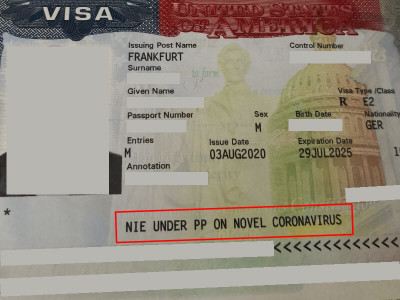Due to the COVID-19 pandemic, a far-reaching entry ban has been in place between January 2020 and November 2021. In the meantime, the U.S. authorities have introduced National Interest Exceptions (NIE), which allowed travel to the U.S. for persons whose entry is of national interest.
Since the Travel Ban to the U.S. was lifted on November 8, 2021, NIEs have also lost their priority status. NIEs approved on the basis of the US travel ban are no longer valid.
However, NIEs may still be used in special situations in the future. We will give you an intensive insight into the topic here.
In order to allow entry into the United States in times of Corona for certain travelers from travel ban regions (Schengen area, Brazil, China, Great Britain, India, Iran, Ireland, Northern Ireland, South Africa), certain exceptions have been created by the U.S. authorities. These National Interest Exceptions (NIE) were exclusively based on national interests.
Individuals who needed to travel to the United States before the U.S. entry ban was lifted were allowed to enter the U.S. in urgent and important exceptional cases – but only with prior official permission from the U.S. consulate or U.S. embassy. It is mandatory to apply for NIE exemptions prior to travel.
In order to be exempt from the U.S. entry ban in 2020 and 2021 and get a waiver, NIE applicants had to prove and justify that their physical presence in the United States was absolutely necessary and that their entry into the United States was a matter of national interest.
The urgency and importance of the entry had to be necessarily in the interest of the United States. If the travel was urgent solely for the traveler or the company assigning th employee, then this did not constitute a NIE criterion. For example, vacation travel, non-urgent travel for family visits, travel for non-urgent medical treatment, transit, etc. did not qualify for receipt of a NIE waiver.
The U.S. Department of State and the U.S. Department of Homeland Security determined which foreign U.S. travelers were subject to these specific exemptions.
Since the new Presidential Proclamation 10294 went into effect on November 8, 2021, a COVID-19 vaccination and testing requirement applies to nearly all U.S. travelers. Persons whose entry is in the national interest of the U.S. may enter the United States unvaccinated or without complete corona vaccination on the basis of certain exceptional reasons and require official confirmation.
This is determined by the U.S. Department of State, U.S. Department of Homeland Security and U.S. Department of Transportation.
It is currently unclear how this will be implemented and which U.S. authority will be responsible for the application process.

National Interest Exception in the annotation
The U.S. authorities determined which individuals were able to apply for a National Interest Exception (NIE). However, this had tot be checked regularly in advance of the application due to constant changes.
In general the following individuals could obtain a National Interest Exception:
Also, the NIE regulations applied uniformly to individuals from
The following persons qualified for a waiver due to national interest:
| Corona travel ban National Interest Exception | |
| individuals who provide "vital support or executive direction for critical infrastructure or critical infrastructure-related supply chains in the U.S." | |
| individuals who provide "vital support or executive direction for significant economic activity in the United States" | |
| health professionals working on COVID-19 containment / persons working in the health care sector | |
| persons traveling for humanitarian or medical emergencies | |
| persons traveling for U.S. national security reasons | |
| harvest workers | |
| service providers for U.S. authorities (e.g. military) | |
| pilots / aircrew traveling for training purposes and aircraft pickup, delivery, or maintenance (ESTA, B-1 visas, B-1/B-2 visas , M-1 visas, and certain dependents with M-2 visas) | |
| journalists (I visas) | |
| immigrant or fiancé visa applicants (K-1 visas) | |
| certain exchange visitors (J-1 visas; e. g. au pairs with special skills) | |
| certain academics and students (J-1 visas) | |
| students (F-1 or M-1 visas)* |
* Students qualified for a blanket NIE, meaning they are automatically considered for the National Interest Exception upon U.S. entry and do not need to submit a separate NIE application.
Family members were also able to apply for a National Interest Exception if the principal applicant's travel fell into the above categories.
Apart from this, the general exceptions to the U.S. entry ban continued to apply, including U.S. citizens, Green Card holders and their immediate family members, as well as air and sea crew (C-1/D visas). Individuals covered by a general exception did not require prior NIE authorization.
Individuals who were not subject to the entry ban did not need a National Interest Exception (NIE) to enter the United States. These included:
The application for National Interest Exception (NIE) had to be submitted usually to the U.S. consulate, regardless of whether a valid visa or ESTA approval was available or whether a new U.S. visa was being applied for.

Basically, the NIE application was about supporting the urgency and importance of the trip to the United States. It was necessary to demonstrate that the planned activity had to physically take place in the United States and could not be rescheduled or conducted remotely.
Therefore, in general, the following NIE application documents, among others, had to be prepared:
We were able to submit many successful NIE applications for our customers in Europe. The application process for a National Interest Exception (NIE) at a U.S. consulate in Germany could be summarized as follows:
| NIE request with existing visa / ESTA | NIE request when applying for a visa |
| 1. Contact the U.S. consulate | |
| request by e-mail to the responsible U.S. consulate | regular visa appointment or emergency appointment (depending on visa category and consulate) |
| 2. Submission of the NIE application documents | |
| via e-mail | during the visa appointment with regular visa application documentation |
| 3. Examination by U.S. consulate | |
| processing time approx. 7-30 days | examination on the day of the visa appointment if the conditions for visa and NIE are met |
| 4. Granted NIE | |
| NIE approval by e-mail (waiver is also electronically registered) | visa issuance (waiver is also electronically registered) |
| 5. Refused NIE | |
| entry currently not possible | visa refusal (exclusion from VWP / ESTA, if applicable); entry currently not possible |
An alternative was to file a NIE application with U.S. Customs and Border Protection (CBP) at the airport where the landing was planned. In this case, the respective CBP office had to be contacted in advance of the trip to the U.S. and the respective procedure had to be asked for. NIEs issued by CBP were still only valid for 30 days for a single entry into the United States. Ideally, the NIE application was therefore submitted at the U.S. consulate or embassy.
A Corona travel ban NIE approved by a U.S. embassy or U.S. consulate could be used for multiple entries within a 12-month period from the date of approval – however, the purpose of entry or stay had to be similar to the initial NIE approval.
After the expiration of this permit period or when using a new passport, a new NIE had to be applied for when entering the country again.
For those who already hold a valid ESTA permit or U.S. visa, there is no additional cost for a National Interest Exception application.
For holders of a valid ESTA authorization or a U.S. visa, there were no additional costs for a National Interest Exception application. For a NIE application as part of a visa or ESTA application, the respective application fees for the visa or ESTA must be paid; however, again there was no "NIE extra charge".
If you hired our US Visa Service to apply for an NI Exception, we charged a handling fee for advice and assistance throughout the NIE application process (including compiling all necessary NIE application documents, assistance in preparing English-language NIE justification letters and email templates, guidance on special entry formalities, etc.).

Sources:
https://de.usembassy.gov/covid19-faqs-for-visas
https://www.cisa.gov/critical-infrastructure-sectors
Version_3.0_CISA_Guidance_on_Essential_Critical_Infrastructure_Workers_1.pdf
Wir und unsere Partner nutzen Cookies, um personenbezogene Daten wie z.B. Browsing-Daten zu speichern und abzurufen, um z.B. Inhalte und Werbung bereitzustellen und zu personalisieren sowie die Verwendung der Website zu analysieren und das Benutzererlebnis zu verbessern. Sie erfahren mehr über die Zwecke, für welche wir und unsere Partner Cookies einsetzen, wenn Sie unten auf den Button „Cookie Einstellungen“ klicken. Hier können sämtliche Einstellungen auch geändert werden. Nachträglich kann man jederzeit seine Cookie-Auswahl überdenken oder seine Einwilligung widerrufen, indem man auf den Link zu den Cookie-Einstellungen im Footer unserer Webseite klickt. Beachten Sie bitte, dass das Blockieren einiger Cookie-Typen unsere Möglichkeiten zur Bereitstellung von auf Ihre Interessen zugeschnittenen Inhalten haben kann oder einige Funktionen der Webseite nur eingeschränkt zur Verfügung stehen.
Durch klicken auf “Alle Cookies akzeptieren” stimmen Sie unserer Nutzung und der Weitergabe Ihrer Daten an unsere Partner zu.